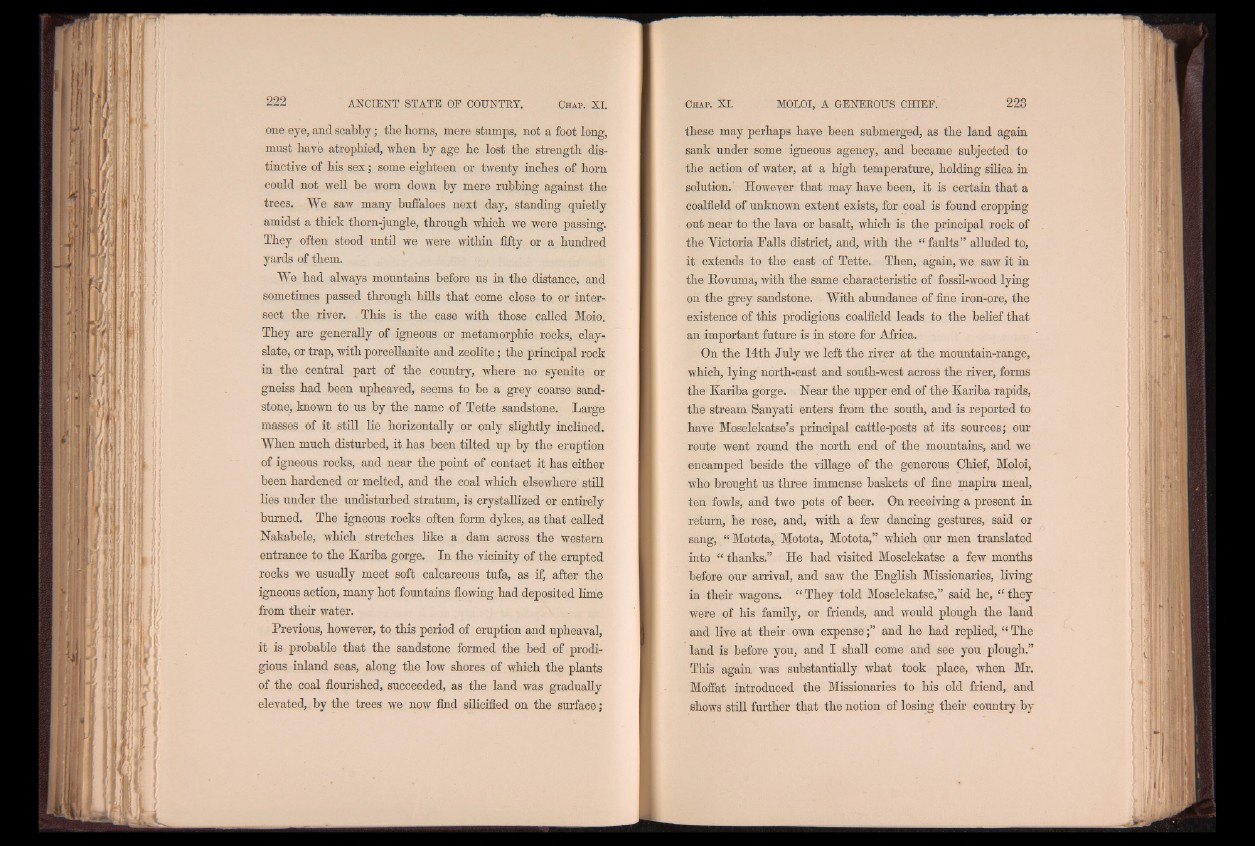
one eye, and scabby; the horns, mere stumps, not a foot long,
must hare atrophied, when by age he lost the strength distinctive
of his sex; some eighteen or twenty inches of horn
could not well be worn down by mere rubbing against the
trees. We saw many buffaloes next day, standing quietly
amidst a thick thorn-jungle, through which we were passing.
They often stood until we were within fifty or a hundred
yards of them.
We had always mountains before us in the distance, and
sometimes passed through hills that come close to or intersect
the river. This is the case with those called Moio.
They are generally of igneous or metamorphic rocks, clay-
slate, or trap, with porcellanite and zeolite; the principal rock
in the central part of the country, where no syenite or
gneiss had been upheaved, seems to be a grey coarse sandstone,
known to us by the name of Tette sandstone. Large
masses of it still lie horizontally or only slightly inclined.
When much disturbed, it has been tilted up by the eruption
of igneous rocks, and near the point of contact it has either
been hardened or melted, and the coal which elsewhere still
lies under the undisturbed stratum, is crystallized or entirely
burned. The igneous rocks often form dykes, as that called
Nakabele, which stretches like a dam across the western
entrance to the Kariba gorge. In the vicinity of the erupted
rocks we usually meet soft calcareous tufa, as if, after the
igneous action, many hot fountains flowing had deposited lime
from their water.
Previous, however, to this period of eruption and upheaval,
it is probable that the sandstone formed the bed of prodigious
inland seas, along the low shores of which the plants
of the coal flourished, succeeded, as the land was gradually
elevated,, by the trees we now find silicified on the surface;
these may perhaps have been submerged, as the land again
sank under some igneous agency, and beeame subjected to
the action of water, at a high temperature, holding silica in
solution. However that may have been, it is certain that a
coalfield of unknown extent exists, for coal is found cropping
out near to the lava or basalt, which is the principal rock of
the Victoria Falls district, and, with the “ faults” alluded to,
it extends to the east of Tette, Then, again, we saw it in
the Eovuma, with the same characteristic of fossil-wood lying
on the grey sandstone. With abundance of fine iron-ore, the
existence of this prodigious coalfield leads to the belief that
an important future is in store for Africa.
On the 14th July we left the river at the mountain-range,
which, lying north-east and south-west across the river, forms
the Kariba gorge. Near the upper end of the Kariba rapids,
the stream Sanyati enters from the south, and is reported to
have Moselekatse’s principal cattle-posts at its sources; our
route went round the north end of the mountains, and we
encamped beside the village of the generous Chief, Moloi,
who brought us three immense baskets of fine mapira meal,
ten fowls, and two pots of beer. On receiving a present in
return, he rose, and, with a few dancing gestures, said or
sang, “ Motota, Motota, Motota,” which opr men translated
into “ thanks.” He had visited Moselebatse a few months
before our arrival, and saw the English Missionaries, living
in their wagons. “ They told Moselekatse,” said he, “ they
were of his family, or friends, and would plough the land
and live at their own expense;” and he had replied, “ The
land is before you, and I shall come and see you plough.”
This again was substantially what took place, when Mr.
Moffat introduced the Missionaries to his old friend, and
shows still further that the notion of losing their country by